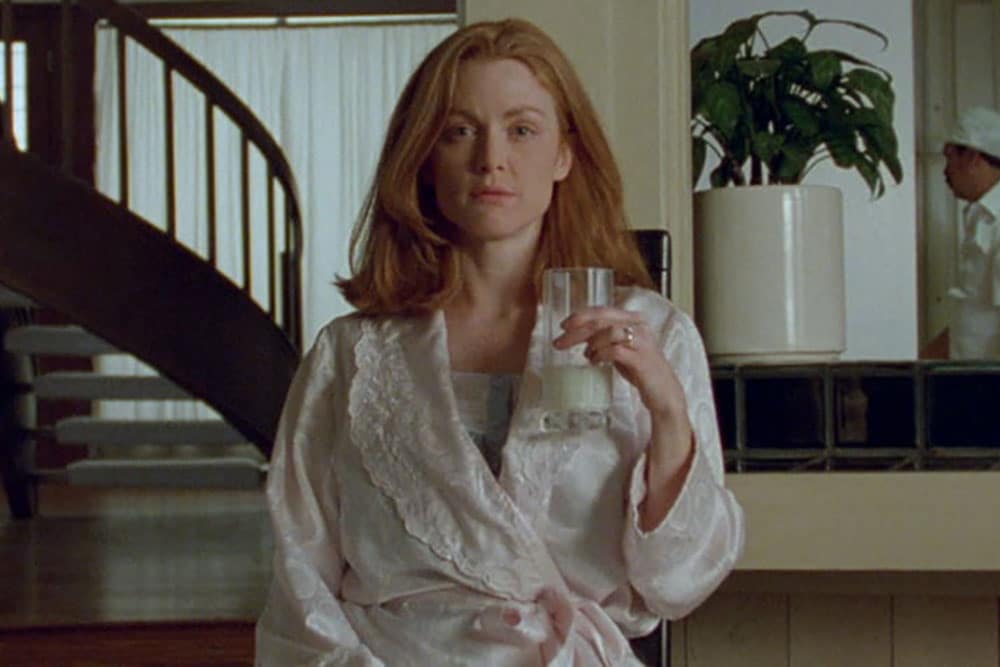
Many films in the slender but beloved filmography of Todd Haynes deal explicitly with popular culture: the glam rock fictionalization of Velvet Goldmine, the Dylan mythologizing of I’m Not There, or the adaptation of Douglas Sirk melodrama tropes for Far From Heaven. Yet Safe, by many measures his breakthrough film and often cited as his best, locates itself in a reality both more grounded and eerily unfamiliar than his other films.
A recent-period piece when it was released in 1995, Safe, just added to the Criterion Collection, takes place in 1987, as Carol White (Julianne Moore), a comfortably wealthy housewife in the San Fernando Valley, accumulates symptoms of… something. She sneezes and coughs. She develops a rash. She feels unwell.
None of the symptoms are particularly troubling on their own, and her doctor can’t find anything wrong, yet they persist. She does not get better. She may be getting worse. Carol eventually adopts the vaguely unhelpful label of “environmental illness” to describe her problem, which doesn’t respond to treatment. Haynes makes her seemingly normal environment appear strange – with pale greens, light pinks, and cream colors, many houses look like fancy day-old cakes. This effect makes Carol appear strange in her home, the camera dwarfing her with wide shots of her surroundings.
The scenes of Carol just not getting better have the intensity of a slow-building horror film. In a scene as simple as Carol driving through an underground garage, trying to find someplace to park during an unexplained coughing fit, Safe summons terror of the unknown, reflecting the era of AIDS, when the film is set. Carol doesn’t have AIDS, though it’s name-checked a few times once she finds a community designed to address her illness. Even there, it’s unclear whether Carol is healing, and her guru’s serene preaching (Peter Friedman) doesn’t inspire much confidence. Still reacting to the “chemicals” around her, Carol doesn’t appear perturbed. She cautiously estimates to her family that she may be getting better as she lugs around an oxygen tank and switches to even more sterile, secluded housing.
Watching Safe nearly 20 years after its debut, rewinding to a point before its lead actress’s fame, it’s remarkable how reticent Moore appears. She makes her voice softer and higher than usual, as if, as Moore notes elsewhere on the disc, it can’t bear any weight. Carol barely protests about anything happening to her, most events barely registering. Her illness, then, makes her body seem like it’s doing the protesting for her. What it’s protesting doesn’t seem clear to her, but there’s plenty to choose from: her banal marriage, her lack of direction, the plastic-sealed fakeness of her everyday life.
Moore would go on to assay other lost Californians in her career: for Paul Thomas Anderson in both Boogie Nights (1997) and Magnolia (1999), and recently for David Cronenberg in Maps to the Stars. (2014). Those are showier, more emotional roles from showier directors; Haynes takes a more academic, allegorical approach to his work. This makes Safe, like many Haynes films, inspired on a conceptual level but not always especially engaging to watch, especially in its less unnerving second half. At times, Safe seems like a series of thoughtful discussion points rather than a full-blooded story designed specifically for a soulless film studies interpretation.
Haynes and Moore discuss this academic quality to Safe in an interview on the disc. The disc’s commentary track is taken from its original DVD release, which means it lacks further perspective, especially on the Haynes/Moore collaboration that would later extend into Far From Heaven and I’m Not There.
Perhaps sensing the potential gap, the Criterion DVD (and Blu-ray, unseen by this critic) includes a 30-minute feature where Haynes and Moore speak to each other about the film and their working relationship. In it, Haynes admits that he tends to approach his writing from a more conceptual, idea-based vantage point, and Moore talks about bringing humanity to his approach while not overacting, giving Haynes room to shape the performance with his framing and pacing.
To a degree, they both succeed: Safe is among the filmmaker’s most immediate works, up there with I’m Not There, which has the advantage of a more experimental, playful tone and a sprawling cast of Bob Dylan impersonators. But for better or worse, the hushed sterility in the filmmaking of Safe makes poor Carol White seem even more like the victim of an unknowable exercise.


![Call for Papers: All Things Reconsidered [MUSIC] May-August 2024](https://www.popmatters.com/wp-content/uploads/2024/04/all-things-reconsidered-call-music-may-2024-720x380.jpg)



